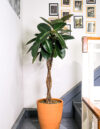Autumn signs are here, and we can see that our plants are gradually changing. They seem to become a bit more subdued. But this isn’t a cause for concern—it’s just a good time to adjust your care routine. Be prepared for your plants to go through a few changes.
- Should we water less or not?
Watering less during the cold months seems logical because plant growth slows down in colder temperatures. However, this isn’t entirely accurate. Most of the water plants take up isn’t used for growth but is lost through transpiration. In winter, when the air is dry, plants lose more water through transpiration. Depending on your indoor conditions (especially if you are increasing the humidity), some plants may need more frequent watering in winter than they do in summer.
There’s only one way to find out: check each plant every four or five days by sticking your finger into the soil. If it’s dry, water it well, otherwise you can wait another four or five days and try again.
- Don’t let your plants dry out: moisture is your ally
Did you know that the relative humidity of a heated home in very cold weather can drop to 15% or less? That means the air is drier than in the Sahara desert, where 25% is the usual minimum. And that most plants need at least 50% relative humidity to grow well?
To correct the problem, put a humidifier in the room where you have the plants. Or group them, putting those with the thinnest leaves (more sensitive to dry air than those with thick leaves) in the center and the others around. Since every plant releases moisture through transpiration, all plants will benefit from increased moisture, especially the more fragile ones in the centre. Or fill a gravel tray and place the plants on it, without a saucer (not necessary as the tray will catch any excess water).
- Postpone the pot change until spring
Replanting is not welcome in winter when root growth is slow. We recommend waiting until spring and a new growth period to replant. If the plant needs it though, it’s okay to cut it back a bit while it’s dormant.
- Give your best from… the light in the house
To compensate for the short, gray days of winter, place the plants closer to the window, even move them to a brighter room. Also consider that large windows let in more light than small ones. Leave the blinds and curtains open during the day and clean the windows (dust and dirt greatly reduce light penetration). It is also possible to use artificial lighting, including fluorescent lamps, to increase the length of the day. A simple fluorescent lamp can even allow many houseplants to grow throughout the winter as if it were summer. There are now LED lamps that provide similar lighting.
- Spraying doesn’t help you much
Manually sprinkling plants with water, which is often recommended, could be a waste of time: the effect lasts only a few minutes, which is not enough to really serve the plants. To help them, the air must remain moist at all times.
- Easy with fertilizers
It’s never a good idea to encourage plant growth when the light is poor: this will encourage etiolation, a situation where plants appear to stretch toward the light with unusually long stems and pale green leaves. This is not a healthy growth and you do not want to encourage it. Therefore, we recommend that you resume fertilizing only in March when the days begin to seriously lengthen.
If you give them reasonable care, your houseplants will spend the winter in good conditions and will be more beautiful than ever when spring comes again!
With love,
F L O R A L S O U L 🌿
 Schefflera Twisted
Quantity: 1 7.500 MDL
Schefflera Twisted
Quantity: 1 7.500 MDL  Ficus Burgundy on Stem
Quantity: 1 3.500 MDL
Ficus Burgundy on Stem
Quantity: 1 3.500 MDL 
